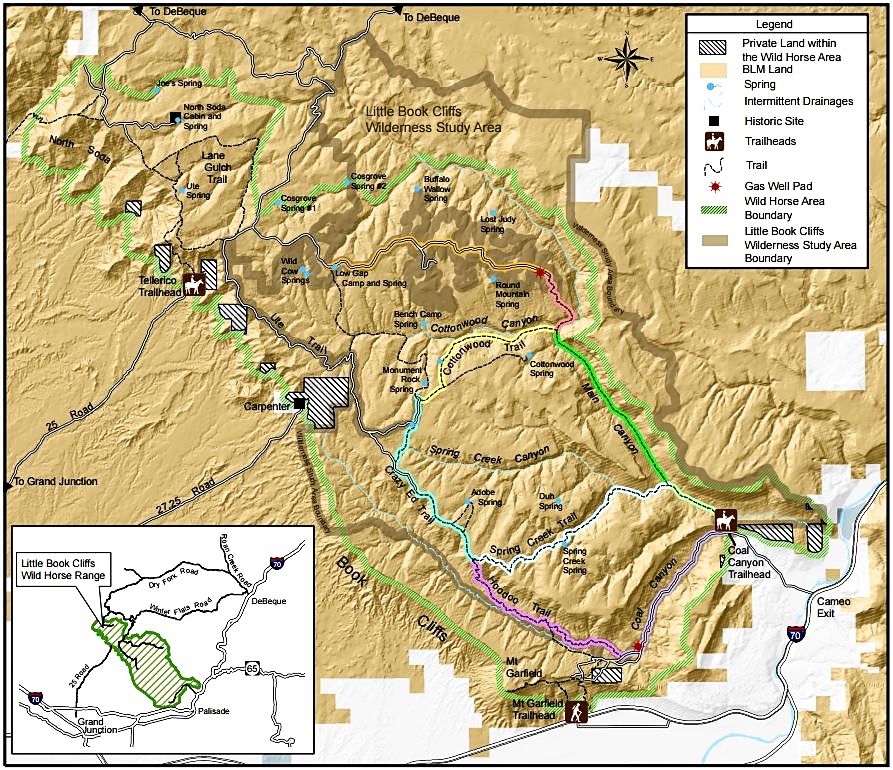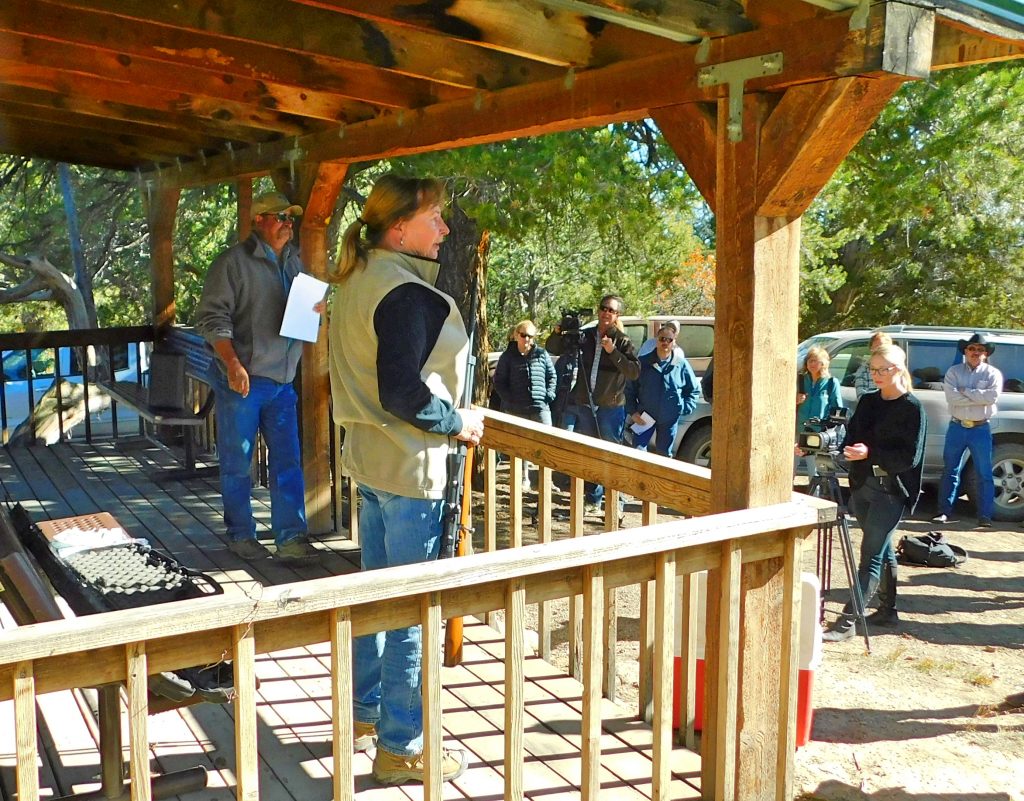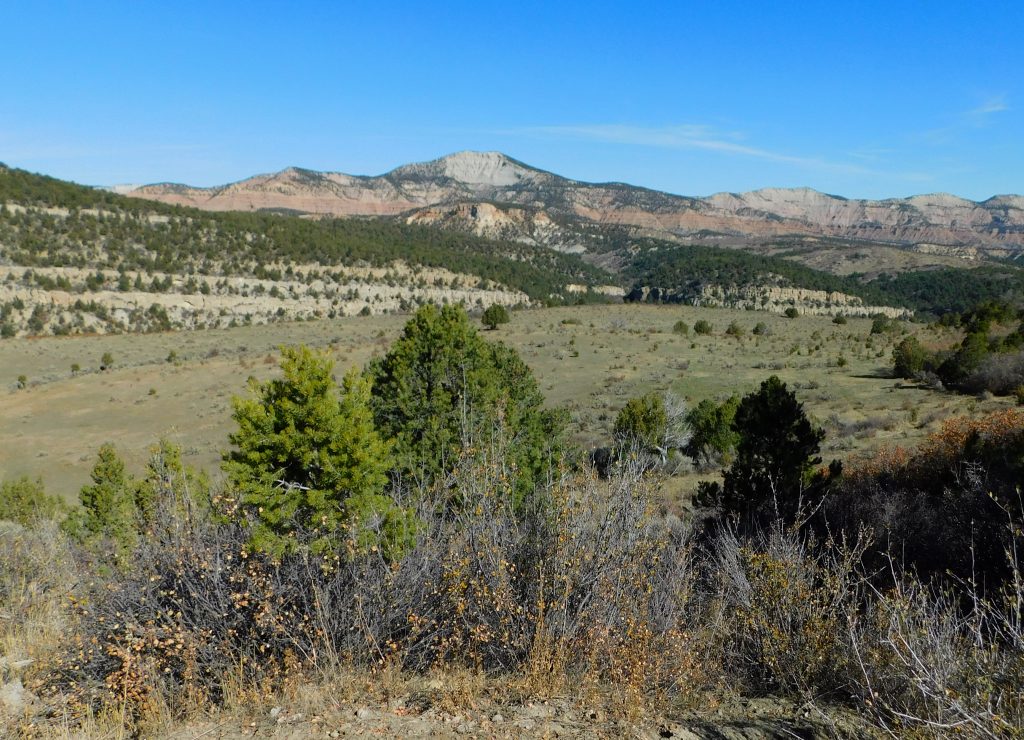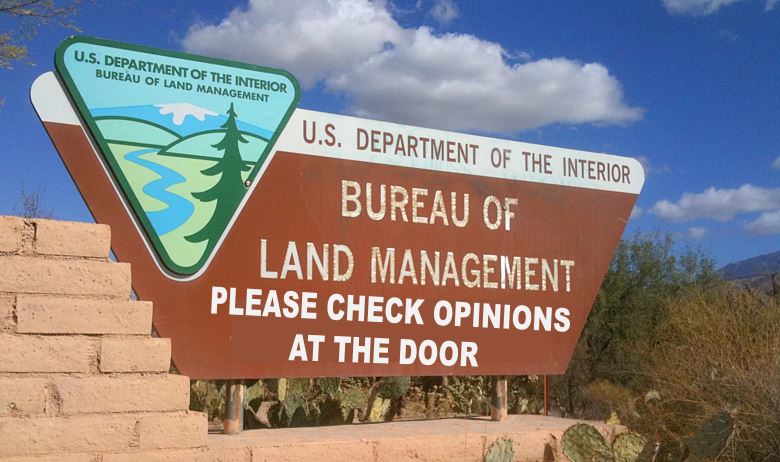Decades ago, ranchers with allotments in the area voluntarily withdrew their herds so the horses would have no feeding competition from cattle or sheep. Because the herds are intensively managed, with the regular introduction of new genetic stock, the horses are generally robust, though slightly smaller in height than other wild horses.
by Marjorie Haun
America’s wild horses, with hundreds of herds in the West, face a bleak future without dramatic management reforms. The Bureau of Land Management (BLM), under the 1971 Wild and Free Roaming Horse and Burro Act, is tasked with managing and protecting these animals, but with at least 50,000 excess animals now on the range, the agency is facing a crisis of suffering, hunger, range destruction, and protracted court battles. There are, however, some success stories which provide a model for management strategies, but as in the case of the Little Book Cliffs’ herd, even a best-case scenario is fraught with challenges.

BLM rangers, along with members of the Wild Horse and Burro Advisory Board, hosted a tour of the Little Book Cliffs wild horse management area, north of Grand Junction, Colorado, on Tuesday, November 17. The tour preceded two days of BLM-sponsored public meetings regarding wild horse and burro management policies; what is working to keep herds healthy and manageable, what is not, and what policies must be changed.
The Little Book Cliffs management area is about 36,000 acres in size and is rimmed by steep escarpments on the south, which create an natural containment feature for the wild horse herds. Although the number of horses there is small compared to larger management areas, the appropriate management level (AML) for horses in the Little Book Cliffs is about 150, and the herd currently exceeds that number. Nevertheless, the Little Book Cliffs horses are faring far better than many herds in Colorado and other Western States.

Although the horses coexist with mule deer. big horns and elk, there are currently no livestock operations on the Little Book Cliffs. Decades ago, ranchers with allotments in the area voluntarily withdrew their herds so the horses would have no feeding competition from cattle or sheep. Because the herds are intensively managed, with the regular introduction of new genetic stock, the horses are generally robust, though slightly smaller in height than other wild horses.
BLM enjoys the assistance of a dedicated group called the Friends of the Mustangs, a self-funded volunteer organization which assists the BLM with its management efforts, and donate thousands of volunteer hours each year to track, identify, and dart horses. The Friends also hosts small tour groups on the range to visit the horses. Between BLM operations and visits by citizens, the human presence on the Little Book Cliffs is almost constant, so unlike most wild horse herds, these animals are unusually approachable.

The primary management tools in the Little Book Cliffs are fertility control in mares, and adoptions, which occur every few years, depending on how many horses exceed the AML. Population control efforts began in 2002 with several years of research on behavior and herd sizes, and full implementation of the program beginning in 2006. Several Friends volunteers have become proficient in darting horses as a means to make mares temporarily infertile. Dart guns are used to shoot PZP (porcine zona pellucida), a contraceptive ‘vaccine,’ into the hindquarters of mares, which causes infertility for about a year. The initial dose of PZP must be followed up with a booster about 30 days following the first dart, with the process repeated each year thereafter for as long as the mare is to remain infertile. The version of PZP currently used by BLM costs about $30 per dose, but a new mixture which combines the vaccine with the booster, is $450 per dose.
Prior to fertility control efforts in this management area, the herd produced around 30-40 foals per year, requiring gathers to occur every two to three years. With the fertility control measures in place, the number of foals has dropped to around 10-17 foals per year, cutting the rate of population growth by half. This year, the number of mares BLM hopes to treat is 44, but to date only about half that number has been successfully darted, and in about 10 percent of that number, the PZP will fail to make the horse infertile. Although there is a measure of success with this fertility control program, it requires intensive management, and would be impossible without the help of willing volunteers.

Because the horses are relatively tame, and do not bolt when people are near, this has made identifying and darting mares much easier than in skittish herds. The voluntary withdrawal of AUM’s (animal unit month) by ranchers, and the natural containment of the herd by steep cliffs to the south and deep ravines to the north make the Little Book Cliffs wild horse area, in some ways, a best case scenario for successful management. But with dedicated volunteers assisting a relatively small herd in a self-contained area, it is an exception to the rule.

Because of the intensive research and care that has gone into fertility control and introduction efforts, this horse herd has largely escaped problems of inbreeding, overgrazing, range destruction, and starvation. Nevertheless, there are groups of horses in this herd which elude easy management, and are hard to track and dart because of rugged terrain. In those pockets of hard-to-reach animals, fertility control has been much less successful.
Although the number of animals in Little Book Cliffs exceeds AML’s by about 30, and some animals evade fertility control efforts, in comparison to other herds in Colorado the issues are minor. East of the Little Book Cliffs, wild horses in the Piceance Basin are suffering from overpopulation, with numbers significantly over AML’s. And to the west, the West Douglas herd suffers from genetic problems due to severe inbreeding.
The BLM sorely needs additional tools to address the tens of thousands of Western wild horses that are in trouble. Stymied by horse ‘advocate’ groups’ lawsuits, the agency has failed to control horse populations, and because wild horses are generally aggressive on the range, adaptable, and robust pro-creators, their populations have become unsustainable, and it’s only getting worse.
America’s wild horses require management, and would ideally receive the kind of intensive management from which the Little Book Cliffs herd benefits. Because the West is generally arid, with little water and sparse forage, even where there are no livestock present, the horses are competing with wildlife, and where their numbers are exploding, they are overrunning and destroying vegetation and range soils. Congress is considering legislation that will provide the BLM with additional management options, and though ‘advocate’ groups oppose some of the most important and effective approaches, including sterilization, sales without restriction, and euthanasia for distressed or sick animals, all tools are required if the horses are to run in healthy and sustainable herds.
[paypal_donation_button]
Free Range Report
[wp_ad_camp_3]
[wp_ad_camp_2]



